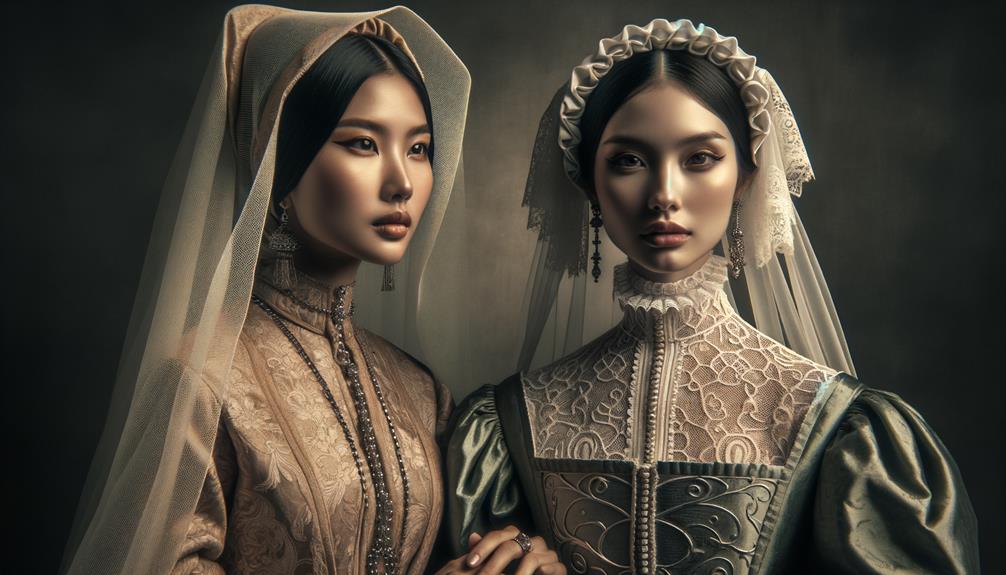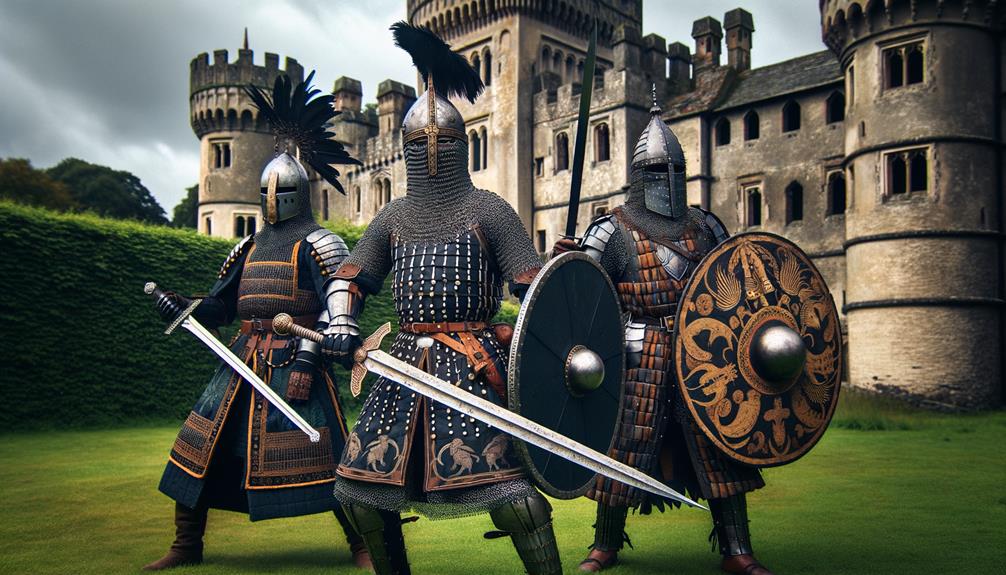I've observed a profound connection between medieval fashion and religious beliefs. Clergy members wore ornate chasubles and dalmatics, adorned with symbolic colors like red and white, reflecting their spiritual roles. Common people incorporated religious symbols into their clothing, often silently praying or expressing devotion. Colors like blue and gold carried specific meanings, such as loyalty and divine glory. The influence of saints was also evident, as people emulated their images as a form of personal expression. Over time, fashion shifted from flowing robes to more fitted outfits, with accessories like brooches adding a touch of elegance. A closer examination reveals even more layers to this fascinating intersection of faith and fabric.
Clergy Attire and Significance
Clergy attire in the Middle Ages was more than just clothing; it embodied the spiritual and hierarchical essence of the church. I often marvel at how each garment, from chasubles to dalmatics, served as more than mere fabric. They featured symbolic motifs, each stitch and color intentionally chosen. White denoted purity, red symbolized martyrdom, and purple signified royalty. These colors weren't random; they were imbued with deep, spiritual meanings.
Observing the hierarchical structure, I noticed that bishops and cardinals wore the most elaborate robes. Their attire, rich and ornate, clearly indicated their elevated status within the church. A simple stole could speak volumes about one's rank and role. The clergy's robes acted as visual sermons, conveying spiritual truths and hierarchical order without uttering a word.
What strikes me most is the dual function of these garments. They were practical, yet profoundly symbolic. Each piece of clergy attire was a coded language, a tapestry of spiritual and social cues. In a time seeking innovation, the medieval church had already mastered the art of communication through fashion. Their attire was a blend of practicality and profound symbolism, an enduring declaration to their time.
Laypeople's Religious Motifs
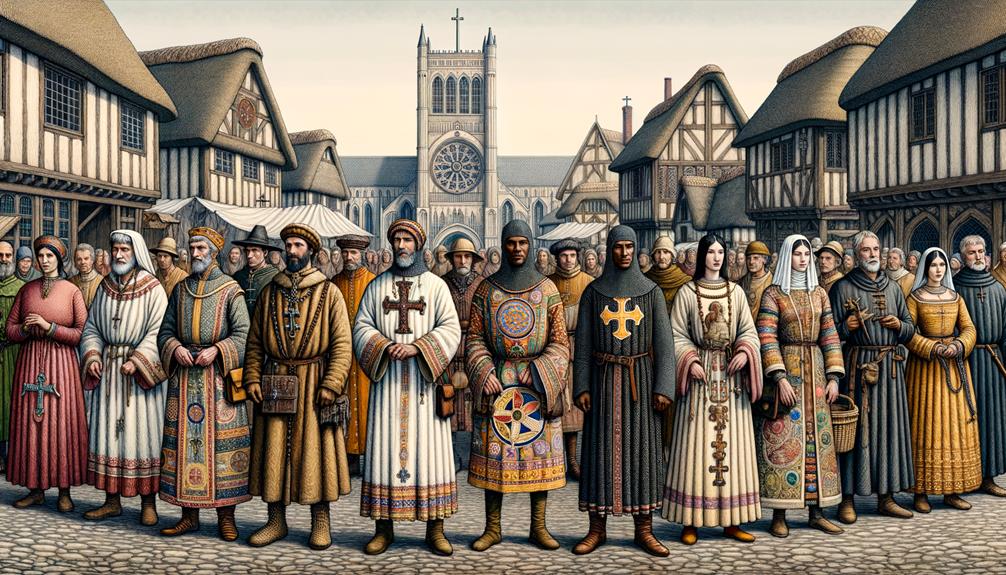
In the Middle Ages, ordinary people wore religious motifs on their clothing to showcase their faith and devotion. These symbols were more than just decorative; they were physical expressions of piety. Crosses, saints, and biblical scenes embroidered onto garments served as a form of silent prayer and protection.
Commoners often incorporated religious symbols into their clothing to reflect their beliefs. It wasn't just a fashion statement; it was a way to manifest their spirituality in everyday life. Adorning oneself with these images was a powerful declaration of faith. This practice reflected the significant influence of religion on society, where every thread and stitch bore witness to their devotion.
Religious motifs on clothing weren't exclusive to the elite. They transcended social classes, with even the humblest garments featuring intricate designs. This practice symbolized a democratization of religious expression, where faith was woven into the fabric of life. For these individuals, their clothing was a canvas of belief, a way to carry their religion with them at all times.
In this way, religious motifs on clothing became a powerful narrative of medieval spirituality, intertwining faith with daily existence.
Symbolic Colors in Clothing
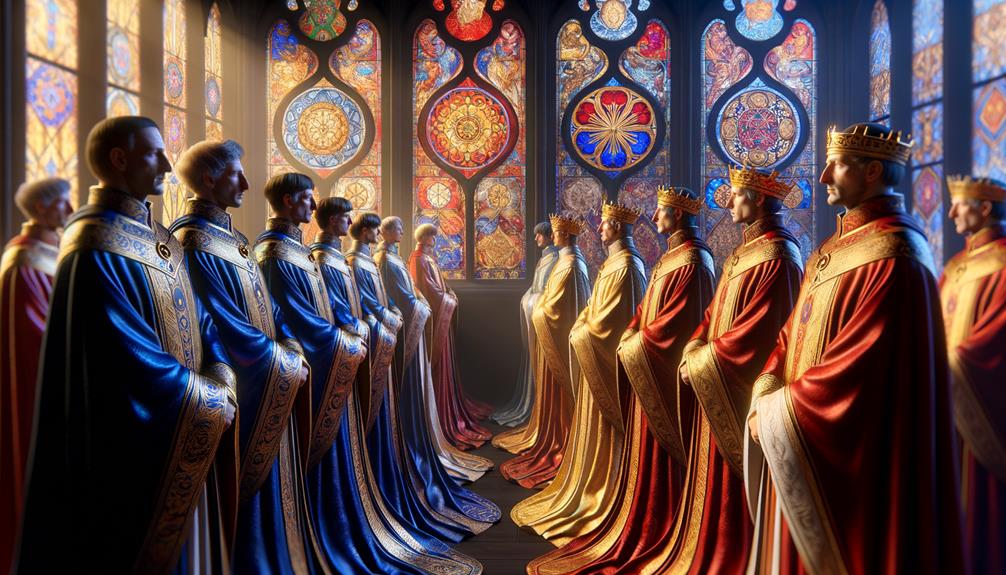
In medieval fashion, the colors people wore were rich with symbolic meaning, reflecting their beliefs and social status. Red, with its vibrant intensity, conveyed passion, love, and martyrdom. It wasn't just a color; it was a declaration of power and spirituality. Royals and clergy often wore red to signify their sacred and powerful roles.
Blue, on the other hand, embodied loyalty, truth, and heavenly connections. It's not surprising to see blue frequently in depictions of the Virgin Mary, symbolizing her purity and divine grace. Blue garments were more than just fabric; they represented an individual's spiritual alignment and trustworthiness.
White garments symbolized purity, innocence, and holiness. Saints and clergy wore white to reflect their inner sanctity. Purple, reserved for those of high rank, represented royalty, power, and wealth. It commanded respect and signified authority.
Lastly, yellow or gold captured the sun's glory, often seen in religious vestments and regal attire. These colors weren't mere choices but carried profound symbolic meanings, intertwining religion and fashion into a complex tapestry of identity and faith.
Roles of Saints in Fashion
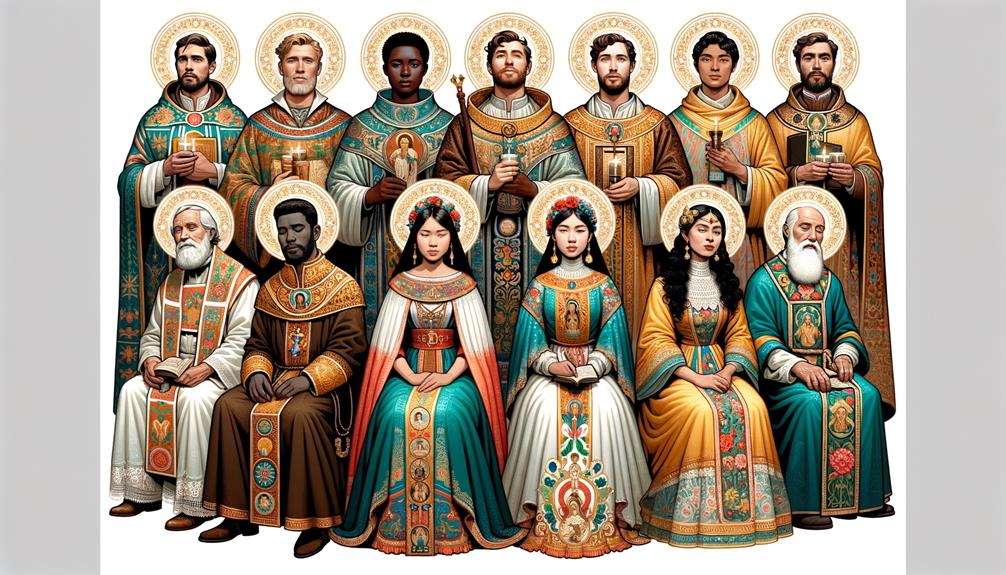
Beyond the symbolic colors, saints' depictions in religious art significantly influenced medieval fashion trends. I'm often fascinated by how these images shaped everyday attire. Saints like Saint Francis of Assisi and Saint Catherine of Alexandria were more than just religious figures; they were style icons. Their distinct attire, immortalized in illuminated manuscripts, became templates for medieval fashion.
The clothing worn by saints wasn't just about aesthetics; it was rich in symbolism. Each garment, each accessory, held deeper meanings. Followers saw these depictions and sought to emulate the virtues represented. The rough robes of Saint Francis, symbolizing humility, became a fashion statement. The regal, intricate gowns of Saint Catherine reflected purity and wisdom, setting a standard for women's attire.
Religious art, with its vivid imagery, offered a visual guide. It wasn't just about faith; it was about identity. Wearing garments similar to those of saints wasn't merely imitation; it was a form of aspiration. People dressed not just to look good, but to embody virtues and spiritual significance. In this way, saints in religious art didn't just influence fashion; they transformed it into a form of personal expression and devotion.
Medieval Fashion Trends
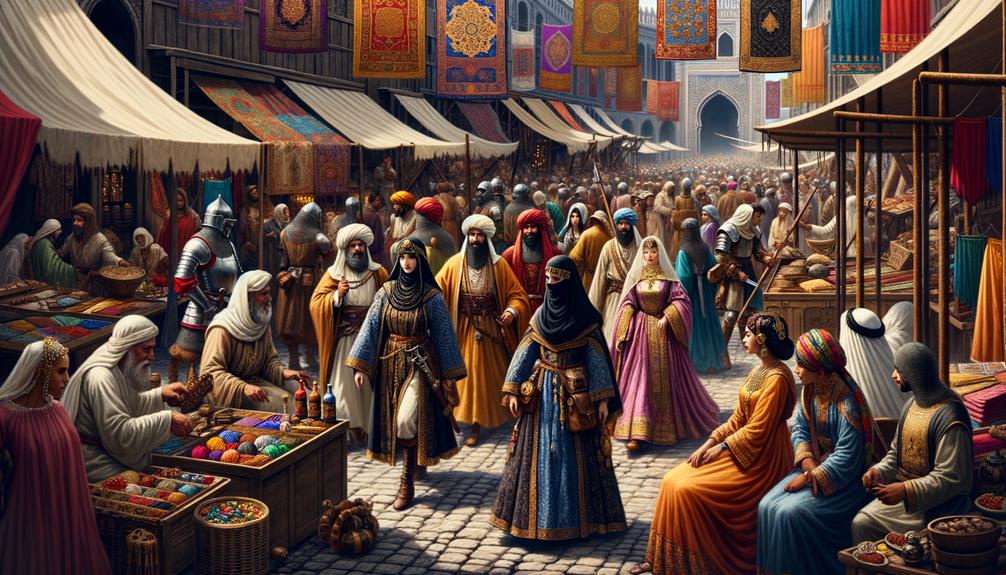
Medieval fashion trends have always fascinated me with their unique blend of practicality and intricate artistry. The transformation from flowing garments to more figure-hugging silhouettes like the cotehardie and bliaut is particularly captivating. The skill of medieval artisans is showcased through pleats and detailed tailoring. Accessories played a crucial role as well, with unique shoe styles like Crakowes and elaborate brooches adding a touch of sophistication.
Sumptuary laws served as a stark reminder of how social status dictated one's clothing choices. These laws regulated everything from fabric quality to color, ensuring that only the elite could afford the finest materials. For Jewish women, these restrictions were even more stringent, often limiting their ability to express individuality through fashion.
Three significant medieval fashion trends stood out to me:
- Figure-Hugging Silhouettes: The evolution from loose garments to fitted ones was a notable shift.
- Intricate Accessories: Brooches, girdles, and Crakowes were staples of medieval fashion.
- Symbolic Jewelry: Talismans and amulets were commonplace, holding significant meaning.
Reflecting on these trends, I noticed a delicate balance between functionality and symbolism, practicality and expression. It's clear that fashion was deeply intertwined with societal norms and personal beliefs. Innovation in medieval clothing wasn't just about aesthetics; it was about navigating the complex web of identity and status.
Frequently Asked Questions
How Does Religion Influence Fashion?
Religion plays a significant role in shaping fashion trends by establishing guidelines for modesty, color palette, and design. I've observed that these influences impact not only daily attire but also ceremonial wear. Observing these influences sparks creativity in finding innovative ways to work within these constraints.
What Did the Religious Orders Wear in the Middle Ages?
In the Middle Ages, religious orders wore distinct habits that reflected their values. Monks favored simple, humble attire, while nuns wore elaborate veils that signified their devotion. Clergy members donned symbolic vestments that conveyed their dedication to their faith. Each piece of clothing emphasized modesty, humility, and a deep commitment to their religious beliefs.
How Does Medieval Clothing Relate to Social Status?
Clothing in medieval times was a reflection of one's social standing. The wealthy nobles wore luxurious fabrics, while peasants wore practical clothing. The colors, materials, and styles of garments conveyed a person's wealth and social status.
What Were the Elements of Medieval Clothing?
Medieval clothing was characterized by tunics, surcoats, and hose for men, while women wore full-length dresses, often accompanied by headwear. Natural fibers like linen, wool, and silk were staples of the medieval wardrobe. Fur trim added warmth and a touch of luxury, signifying social status. Over time, fastening systems evolved to include buttons and lacing, making it easier to secure garments in place.



